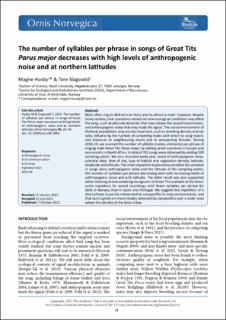| dc.description.abstract | Birds often sing to defend a territory and to attract a mate. However, despite many studies, clear questions remain on how ecological conditions may affect the song, such as physical obstacles that may reduce the sound transmission, and anthropogenic noise that may mask the signal. The social environment of the local populations may also be important, such as breeding density and sex ratio, influencing the number of competing males with which to song match, and distances to neighbouring males and to prospecting females. During 2016-19, we counted the number of syllables (notes, elements) per phrase of singing male Great Tits Parus major by visiting seven countries in Europe and one country in North Africa. A total of 762 songs were observed by visiting 590 sampling points. We also recorded study year, levels of anthropogenic noise, calendar date, time of day, type of habitat and vegetation density, latitude, longitude and altitude. The most important explanatory variables for variation in songs were anthropogenic noise and the latitude of the sampling points; the number of syllables per phrase decreasing both with increasing levels of anthropogenic noise and with latitude. The latter result was also supported when listening to and analysing sonograms of Great Tits available at the Xeno-canto repository for sound recordings, with fewer syllables per phrase for birds in Norway than in Spain and Portugal. We suggest that repetition of a short phrase is quickly interpreted by conspecifics in noisy environments, and that such signals are more readily detected by conspecifics over a wider area where the density of the birds is low. | en_US |

